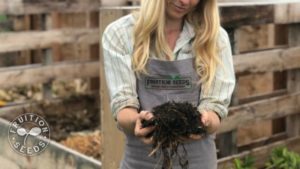Stationary vs Rotation Composting Sat, 10/17 · 5:22 PM5:06 SUMMARY KEYWORDS compoststationarylotscreatingcompostersairturningpilematerialsstructurekindswire fencestotallyaerateputtingscrapshot temperaturestonsfarmorganicgarden
Transcript: For fans, there are two basic kinds of compost and composters. So you’ll find there are stationary composters and there are rotating composters. And you can see our pile here is quite stationary. We do love to turn it but it is pretty much staying right here. And the come, this is the turning ones, you’ll see they have handles and they’re off the ground often. And they tumble along aerating themselves. So you’ve got lots of options, you can totally spend lots of money on a tumbler. And honestly, I don’t personally like them much a because it’s plastic, and you’re getting it up to hot temperatures. Oh, and then you’re putting it on your organic garden. That being said, they’re totally awesome and they make life simple for tons of people. So don’t let me dissuade you. But I’d like to share with you a few different things about having a stationary compost because you can have it be as curated as you like I’ve seen very fancy composters that are very well orchestrated. And they’re beautiful and very effective. And I’ve seen plenty of really basic, equally effective compost piles, including the one I’m sitting right next to this is one here at the farm, we have some highly curated compost as well. But we essentially have one that is it’s a cold compost. And we just throw our kitchen scraps and other materials from the farm that aren’t diseased and it just does its thing and I kind of love it. So if by all means there’s the full spectrum at your fingertips, if you are creating a stationary, whether you’re creating a stationary or a rotating compost, be sure that you’re putting it in a place with lots and lots of sun. location is everything. Your the heat is what is going to be creating that heat and moisture create the biological biological activity, that is the foundation of compost turning into compost. So the sunnier place that you can put your compost, in any construct that you have is going to result in quicker, better compost. And I highly recommend you know, if there you’ve got a lot of options, you can of course, that you can I love the ones that are basically like wooden pallets stacked on three sides if not four and then it’s basically creating this little shed that then the compost can go up. And there’s the slats. So air can infiltrate at various levels. I’ve also seen lots of great compost that is simply you know, like basically chicken wire other kinds of wire fences with some posts so that it has a little more structure. And that also has allows lots of that air that oxygen to come in and aerate and oxidize and help that biology turn into compost that much faster. So you can also just like this one, have it just straight on the ground and not have any structure around it. I would recommend in this case, making sure that there’s tons of carbon material on the bottom, the larger the better. So for example, when we made this pile, we drug lots and lots of branches and twigs, lots of very high carbon materials that were going to stack on top of each other but not evenly and not compact, so that there was lots of oxygen, lots of air circulating at the bottom. So that way, you’re not creating this kind of anaerobic sludge on the bottom. It’s all pretty living throughout. So yet if you’re doing a stationary like ours, keeping it crazy simple without any other structure, at the bare minimum, Don’t slack when it comes to giving it a solid base that’s going to air right. So another thing to keep in mind that you really want to think about. I mean, we have the whole other section about what to put in compost. But especially if you’re doing a cold and stationary compost, it’s utterly essential that you not mess around in the department of putting meat scraps, fish scraps and dairy into your compost pile. Eggs totally kosher. But anything else is you’re kind of asking for not only animals, but in most home compost, those materials are just going to take way too long to compost and sometimes on the order of of years, especially if you’re not diligent about about turning your compost. So there you have it, friends, you’ve got lots of different options in the container department. There’s basically a compost container or lack thereof for every personality type. And now you have the core things to keep in mind to make sure that you have a good healthy compost That will suit your style, and I can’t wait to see what you create


